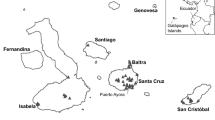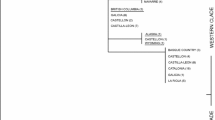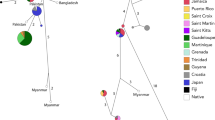Abstract
Biological invasions are among key factors of ecological changes, and social insects appear as highly successful invasive animals. Subterranean termites of the holarctic genus Reticulitermes are present in Europe with six native and one invasive (the nearctic R. flavipes) species. The species R. urbis shows a disjunct distribution in the Western Balkans, Eastern Italy and Southern France. Previous molecular and population genetics data suggested that the taxon originated from the Balkans, and that Italian and French populations are invasive, but it is still unknown how many introduction events occurred and from which Balkan source populations. To address these questions, a population genetics analysis was performed on a larger sampling than previous studies, using mitochondrial cytochrome oxidase II and 6 microsatellite markers on 47 colonies collected across the whole distribution area. Mitochondrial analysis confirmed the presence of two major lineages where colonies from Balkans, Italy, and France intermingle. Similarly, microsatellite loci analysis indicated the presence of two genetic clusters, though not corresponding to the two mitochondrial clades, each including colonies from the three sampled areas and with individuals showing mixed cluster membership. Overall, French and Italian populations showed indications of bottleneck (reduced genetic diversity and change of allele frequencies) and do not appear genetically differentiated from the Balkan population. Results presented here support a history of multiple introductions in Italy and France, in a scenario consistent with continuous exchanges between native and invasive areas, as expected along human trades routes.



Similar content being viewed by others
References
Allendorf FW (1986) Genetic drift and the loss of alleles versus heterozygosity. Zoo Biol 5:181–190
Ascunce MS, Yang CC, Oakey J et al (2011) Global invasion history of the fire ant Solenopsis invicta. Science 331:1066–1068
Astour MC (1985) Ancient Greek Civilization in Southern Italy. J Aesthet Educ 19:23–37
Austin JW, Szalanski AL, Uva P, Bagnères A-G, Kence A (2002) A comparative genetic analysis of the subterranean termite genus Reticulitermes (Isoptera: Rhinotermitidae). Ann Entomol Soc Am 95:753–760
Bagnères A-G, Uva P, Clément J-L (2003) Description d’une nouvelle espèce de Termite: Reticulitermes urbis n.sp. (Isopt., Rhinotermitidae). Bull Soc Entomol Fr 108:433–435
Bignell DE, Eggleton P (2000) Termites in ecosystems. In: Abe T, Bignell DE, Higashi M (eds) Termites: evolution, sociality, symbioses, ecology. Springer, Dordrecht, pp 363–387
Buczkowski G, Bertelsmeier C (2016) Invasive termites in a changing climate: a global perspective. Ecol Evol 7:974–985
Buttermore RE (1997) Observations at successful Bombus terrestris (L) (Hymenoptera: Apidae) colonies in southern Tasmania. Aust J Entomol 36:251–254
Caldera EJ, Ross KG, DeHeer CJ, Shoemaker DD (2008) Putative native source of the invasive fire ant Solenopsis invicta in the USA. Biol Invasions 10:1457–1479
Clement M, Posada D, Crandall KA (2000) TCS: a computer program to estimate gene genealogies. Mol Ecol 9:1657–1659
Dedeine F, Dupont S, Guyot S, Matsuura K, Wang C, Habibpour B, Bagnères A-G, Mantovani B, Luchetti A (2016) Historical biogeography of Reticulitermes termites (Isoptera: Rhinotermitidae) inferred from analyses of mitochondrial and nuclear loci. Mol Phylogenet Evol 94:778–790
Dlugosh KM, Parker IM (2008) Founding events in species invasions: genetic variation, adaptive evolution, and the role of multiple introductions. Mol Ecol 7:431–449
Doyle JJ, Doyle JL (1987) A rapid DNA isolation procedure for small amounts of fresh leaf tissue. Phytochem Bull 19:11–15
Dronnet S, Bagnères A-G, Juba TR, Vargo EL (2004) Polymorphic microsatellite loci in the European subterranean termite, Reticulitermes santonensis Feytaud. Mol Ecol Notes 4:127–129
Evanno G, Regnaut S, Goudet J (2005) Detecting the number of clusters of individuals using the software STRUCTURE: a simulation study. Mol Ecol Notes 14:2611–2620
Evans TA, Forschler BT, Grace JK (2013) Biology of invasive termites: a worldwide review. Annu Rev Entomol 58:455–474
Ferrari R, Ghesini S, Marini M (2011) Reticulitermes urbis in Bagnacavallo (Ravenna, Northern Italy): a 15-year experience in termite control. J Entomol Acarol Res Ser II 43:287–290
Ghesini S, Marini M (2012) New data on Reticulitermes urbis and Reticulitermes lucifugus in Italy: are they both native species? Bull Insectol 65:301–310
Ghesini S, Marini M (2015) Description of a new termite species from Cyprus and the Aegean area: Reticulitermes aegeus sp. nov. Bull Insectol 68:207–210
Ghesini S, Messenger MT, Pilon N, Marini M (2010) First report of Reticulitermes flavipes (Isoptera: Rhinotermitidae) in Italy. Fla Entomol 93:327–328
Goudet J (1995) FSTAT (vers 1.2): a computer program to calculate F-statistics. J Hered 86:485–486
Hagenblad J, Hülskötter J, Acharya KP et al (2015) Low genetic diversity despite multiple introductions of the invasive plant species Impatiens glandulifera in Europe. BMC Genet 16:103
Holt JA, Lepage M (2000) Termites and soil properties. In: Abe T, Bignell DE, Higashi M (eds) Termites: evolution, sociality, symbioses, ecology. Springer, Dordrecht, pp 389–407
Holway DA, Lach L, Suarez AV, Tsutsui ND, Case TJ (2002) The causes and consequences of ant invasions. Annu Rev Ecol Syst 33:181–233
Jeffreys E, Haldon J, Cormack R (2008) The Oxford Handbook of Byzantine Studies. Oxford University Press, New York
Jenkins TM, Dean RE, Verkerk R, Forschler BT (2001) Phylogenetic analyses of two mitochondrial genes and one nuclear intron region illuminate European subterranean termite (Isoptera: Rhinotermitidae) gene flow, taxonomy and introduction dynamics. Mol Phylogenet Evol 20:286–293
Kinziger AP, Nakamoto RJ, Anderson EC, Harvey BC (2011) Small founding number and low genetic diversity in an introduced species exhibiting limited invasion success (speckled dace, Rhinichthys osculus). Ecol Evol 1:73–84
Kolar CS, Lodge DM (2001) Progress in invasion biology: predicting invaders. Trends Ecol Evol 16:199–204
Kutnik M, Uva P, Brinkworth L, Bagnères A-G (2004) Phylogeography of two European Reticulitermes (Isoptera) species: the Iberian refugium. Mol Ecol 13:3099–3113
Lander TA, Klein EK, Oddou-Muratorio S, Candau JN, Gidoin C, Chalon A, Roig A, Fallour D, Auger-Rozenberg MA, Boivin T (2014) Reconstruction of a windborne insect invasion using a particle dispersal model, historical wind data, and Bayesian analysis of genetic data. Ecol Evol 4:4609–4625
Lefebvre T, Chaline N, Limousin D, Dupont S, Bagnères A-G (2008) From speciation to introgressive hybridization: the phylogeographic structure of an island subspecies of termite, Reticulitermes lucifugus corsicus. BMC Evol Biol 8:38
Leniaud L, Dedeine F, Pichon A, Dupont S, Bagnères A-G (2009a) Geographical distribution, genetic diversity and social organization of a new European termite, Reticulitermes urbis (Isoptera: Rhinotermitidae). Biol Invasions 12:1389–1402
Leniaud L, Pichon A, Uva P, Bagnères A-G (2009b) Unicoloniality in Reticulitermes urbis: a novel feature in a potentially invasive termite species. Bull Entomol Res 99:1–10
Librado P, Rozas J (2009) DnaSP v5: a software for comprehensive analysis of DNA polymorphism data. Bioinformatics 25:1451–1452
Luchetti A, Trenta M, Mantovani B, Marini M (2004) Taxonomy and phylogeny of north Mediterranean Reticulitermes termites (Isoptera, Rhinotermitidae): a new insight. Insectes Soc 51:117–122
Luchetti A, Marini M, Mantovani B (2007) Filling the European gap: biosystematics of the eusocial system Reticulitermes (Isoptera, Rhinotermitidae) in the Balkan peninsula and Aegean area. Mol Phylogenet Evol 45:377–383
Luchetti A, Scicchitano V, Mantovani B (2013a) Origin and evolution of the Italian subterranean termite Reticulitermes lucifugus (Blattodea, Termitoidae, Rhinotermitidae). Bull Entomol Res 103:734–741
Luchetti A, Velonà A, Mueller M, Mantovani B (2013b) Breeding systems and reproductive strategies in Italian Reticulitermes colonies (Isoptera: Rhinotermitidae). Insectes Soc 60:203–211
Marini M, Mantovani B (2002) Molecular relationship among European samples of Reticulitermes (Isoptera, Rhinotermitidae). Mol Phylogenet Evol 22:454–459
Mattucci F, Oliveira R, Lyons LA, Alves PC, Randi E (2016) European wildcat populations are subdivided into five main biogeographic groups: consequences of Pleistocene climate changes or recent anthropogenic fragmentation? Ecol Evol 6:3–22
Miura T, Roisin Y, Matsumoto T (2000) Molecular phylogeny and biogeography of the nasute termite genus Nasutitermes (Isoptera: Termitidae) in the Pacific tropics. Mol Phylogenet Evol 17:1–10
Moller H (1996) Lessons for invasion theory from social insects. Biol Conserv 78:125–142
Muirhead JR, Gray DK, Kelly DW et al (2008) Identifying the source of species invasions: sampling intensity vs genetic diversity. Mol Ecol 17:1020–1035
Nei M (1972) Genetic distance between populations. Am Nat 106:283–292
Peakall R, Smouse PE (2012) GenAlEx 6.5: genetic analysis in Excel. Population genetic software for teaching and research—an update. Bioinformatics 28:2537–2539
Pejchar L, Mooney HA (2009) Invasive species, ecosystem services and human well-being. Trends Ecol Evol 24:497–504
Perdereau E, Dedeine F, Christidès J-P, Dupont S, Bagnères A-G (2011) Competition between invasive and indigenous species: an insular case study of subterranean termites. Biol Invasions 13:1457–1470
Perdereau E, Bagnéres A-G, Bankhead-Dronnet S, Dupont S, Zimmermann M, Vargo EL, Dedeine F (2013a) Global genetic analysis reveals the putative native source of the invasive termite, Reticulitermes flavipes, in France. Mol Ecol 22:1105–1119
Perdereau E, Velonà A, Dupont S, Labedan M, Luchetti A, Mantovani B, Bagnères A-G (2013b) Colony breeding structure of the invasive termite Reticuliterme urbis (Isoptera: Rhinotermitidae). J Econ Entomol 106:2216–2224
Perdereau E, Bagnères A-G, Vargo EL, Xu Y, Labadie P, Dupont S, Dedeine F (2015) Relationship between invasion success and colony breeding structure in a subterranean termite. Mol Ecol 24:2125–2142
Piry S, Luikart G, Cornuet J-M (1999) BOTTLENECK: a computer program for detecting recent reductions in the effective population size using allele frequency data. J Hered 90:502–503
Pritchard JK, Stephens M, Donnelly P (2000) Inference of population structure using multilocus genotype data. Genetics 155:945–959
Puillandre N, Dupas S, Dangles O, Zeddam J-L, Capdevielle-Dulac C, Barbin K, Torres-Leguizamon M, Silvain J-F (2008) Genetic bottleneck in invasive species: the potato tuber moth adds to the list. Biol Invasions 10:319–333
Raymond M, Rousset F (1995) GENEPOP (version 1.2): population genetics software for exact tests and ecumenicism. J Hered 86:248–249
Rust MK, Su NY (2012) Managing social insects of urban importance. Annu Rev Entomol 57:355–375
Sarnat EM, Fischer G, Guénard B, Economo EP (2015) Introduced Pheidole of the world: taxonomy, biology and distribution. Zookeys 543:1–109
Schmitt T, Seitz A (2001) Allozyme variation in Polyommatus coridon (Lepidoptera: Lycaenidae): identification of ice-age refugia and reconstruction of post-glacial expansion. J Biogeogr 28:1129–1136
Simon C, Frati F, Beckenbach A et al (1994) Evolution, weighting and phylogenetic utility of mitochondrial gene sequences and a compilation of conserved polymerase chain-reaction primers. Ann Entomol Soc Am 87:651–701
Spencer CC, Neigel JE, Leberg PL (2000) Experimental evaluation of the usefulness of microsatellite DNA for detecting demographic bottlenecks. Mol Ecol 9:1517–1528
Su NY (2002) Novel technologies for subterranean termite control. Sociobiology 40:95–101
Su NY, Scheffrahn RH (2000) Termites as pests of buildings. In: Abe T, Bignell DE, Higashi M (eds) Termites: evolution, sociality, symbioses, ecology. Springer, Dordrecht, pp 437–453
Sugimoto A, Bignell DE, MacDonald JA (2000) Global impact of termites on the carbon cycle and atmospheric trace gases. In: Abe T, Bignell DE, Higashi M (eds) Termites: evolution, sociality, symbioses, ecology. Springer, Dordrecht, pp 409–435
Tamura K, Stecher G, Peterson D, Filipski A, Kumar S (2013) MEGA6: molecular evolutionary genetics analysis version 6.0. Mol Biol Evol 30:2725–2729
Toews DP, Brelsford A (2012) The biogeography of mitochondrial and nuclear discordance in animals. Mol Ecol 21:3907–3930
Tsutsui ND, Suarez AV (2003) The colony structure and population biology of invasive ants. Conserv Biol 17:48–58
Uva P, Clément J-L, Austin JW, Aubert J, Zaffagnini V, Quintana A, Bagneres A-G (2004) Origin of a new Reticulitermes termite (Isoptera, Rhinotermitidae) inferred from mitochondrial and nuclear DNA data. Mol Phylogenet Evol 30:344–353
Vargo EL (2000) Polymorphism at trinucleotide microsatellite loci in the subterranean termite Reticulitermes flavipes. Mol Ecol 9:817–829
Vargo E, Husseneder C (2009) Biology of subterranean termites: insights from molecular studies of Reticulitermes and Coptotermes. Annu Rev Entomol 54:379–403
Velonà A, Ghesini S, Luchetti A, Marini M, Mantovani B (2010) Starting from Crete, a phylogenetic re-analysis of the genus Reticulitermes in the Mediterranean area. Mol Phylogenet Evol 56:1051–1058
Acknowledgements
This work has been supported by Canziani and RFO-UNIBO funding to AL and BM. Authors wish to thank Francesco Nicassio and Mario Marini for the help in collecting samples. Authors are grateful to two anonymous Reviewers, whose comment and suggestions greatly improved the manuscript.
Author information
Authors and Affiliations
Corresponding author
Electronic supplementary material
Below is the link to the electronic supplementary material.
Rights and permissions
About this article
Cite this article
Scicchitano, V., Dedeine, F., Bagnères, AG. et al. Genetic diversity and invasion history of the European subterranean termite Reticulitermes urbis (Blattodea, Termitoidae, Rhinotermitidae). Biol Invasions 20, 33–44 (2018). https://doi.org/10.1007/s10530-017-1510-5
Received:
Accepted:
Published:
Issue Date:
DOI: https://doi.org/10.1007/s10530-017-1510-5




